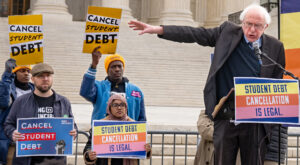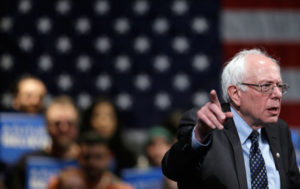Nevada Could Be the Iowa Caucus Fiasco Redux
With the contest less than a week, state Democratic officials appear poised to repeat all of their worst mistakes this election cycle. Ashtyn Renee / Flickr
Ashtyn Renee / Flickr
As new details emerge about what went wrong with the Iowa Democratic Party’s vote counting meltdown in its presidential caucuses, the Nevada State Democratic Party is racing to replace the app that failed in Iowa with new and untested online voting tools in its caucus on February 22—a scenario suggesting some difficulties seen in Iowa may resurface.
Meanwhile, in Iowa, where Bernie Sanders’ campaign has said it will seek a partial “re-canvass” (recount) after the IDP announced that Pete Buttigieg would probably receive 14 national convention delegates and Sanders would receive 12 delegates, the IDP has said that it will not be looking at the ballots (voter-signed presidential preference cards). Instead, the IDP will examine the summary sheets of vote totals signed by the caucus chair and campaign precinct captains, even though the New York Times has reported inaccuracies on those worksheets. That discrepancy implies that questions about the IDP’s vote counting will linger.
In other words, as party-run contests in Iowa continue and are poised to take the stage in Nevada, the riskiest, most controversial and possibly least assuring aspects of these 2020 elections are coming from decisions made by state party officials. These officials tend to be younger and more confident than skeptical of digital technology, and have sided with their vendors more than outside experts.
That state party role has not been recognized in the most detailed press reports offering explanations or more conspiratorial reports casting blame about Iowa’s meltdown. Yet top party officials in both states have resisted warnings from the Democratic National Committee (DNC) about the risks of debuting new digital voting systems. Those warnings have come from the DNC Rules and Bylaws Committee (RBC), which oversees state delegate selection plans, the DNC’s technology staff, and an expert advisory board created by the DNC staff.
The RBC’s 2020 rules envisioned caucus states offering a remote participation option to voters who could not be physically present at the caucuses. But as the months progressed and the details of that system raised reliability and security concerns, the RBC reversed course. In late August, it rejected plans by Iowa and Nevada to offer voters a telephone keypad-based voting option. At the time, the RBC also warned these two states about using online voting systems.
However, Nevada and Iowa pressed ahead with retooling some of their digital voting systems, saying that these would be used by party officials and volunteers, not by voters. The states could push the edge of the envelope because the RBC has limited jurisdiction over how state party-run contests use technology.
“The Rules Committee jurisdiction has never involved counting the votes, because most of the time it is done by state law” affecting government-run party primaries, said Elaine Kamarck, an RBC member from Massachusetts and presidential scholar who said the panel’s main job is overseeing state plans to allocate delegates to the Democratic National Convention. “It never occurred to us to get into the business of [overseeing] vote counting.”
Thus, tech-friendly state party officials, more so in Nevada than Iowa, had a loophole of sorts and pressed on. The fact that state parties, not the DNC, pay for their presidential caucuses strengthened their resolve. So, too, did the months that they had spent developing the telephone voting option (before the RBC killed it).
As reported in most detail in the Nevada Independent, Nevada now plans to give every precinct caucus chair a party-programmed iPad that will import the results from four days of early voting (at the start of each precinct caucus), calculate the candidate rankings in two rounds of voting, and electronically file the results. (Iowa’s app failed to transmit these local results and to compile state totals.)
After the Iowa meltdown, Nevada State Democratic Party chairman William McCurdy II said in a statement, “We will not be employing the same app or vendor used in the Iowa caucus.” The Nevada Independent spoke to caucus chairs being trained in the newest system only days before it will debut. Those volunteers said that the party was describing the use of an iPad as not the same as an app.
“In the [training] video, a party staffer tells volunteers that the new mechanism ‘is not an app’ but should be thought of as ‘a tool,’” the Independent reported. “Asked by a volunteer how results would be transmitted from one place to another, the staffer demurred. ‘Those are all excellent questions, and we’re still working out some of the details around those so I’ll make sure that everyone has more information as we’re able to share it,’ she said.”
Late on Monday, February 10, four days before early voting is set to begin, the Nevada state party updated campaigns about their latest plans, according to the Independent. The party will be using party-provided iPads to check in voters using preloaded county voter rolls (as PDF files). Voters will fill out a paper presidential preference card, but also enter their information on the iPad as a Google form “which will be accessed through a URL,” the Independent reported, citing a party memo. Thus a paper and electronic record of their vote will be created.
The system is reliant on caucus chairs accessing Wi-Fi in 80 early voting sites across the state. It was not clear from the Independent’s report what elements of this system would be used or modified for use in hundreds of precinct caucuses on February 22. In Iowa’s precinct caucuses, getting online was an issue for several campaigns using sophisticated turnout-tracking apps, because attendees in those locations were widely using their phones and competing for the bandwidth.
The Nevada party was still recruiting precinct chairs for those caucuses, according to people with ties to Joe Biden’s campaign in New Hampshire. That update suggests that there may be issues with using an unfamiliar system while running the event.
Nevada party officials have not responded to Voting Booth’s request to comment.
Whether the DNC Rules Committee can step in and order Nevada to fine-tune the vote counting technology to be used—as it affects how 2020 national convention delegates are allocated—is an open question. Meanwhile, party officials from other states with government-run presidential primaries are watching and are frustrated.
“Just use paper ballots, count them by hand, and call in the results,” said an exasperated state vice-chair (a baby boomer) who said that she was friends with McCurdy, but was angry with her younger “techie” peers. (Those comments came before the latest details about Nevada’s early voting system were released.) The Iowa meltdown reminded her of the Obama White House’s rollout of the Obamacare website, where young staffers overlooked what could go wrong when a system debuts.
Not a Stop-Bernie Conspiracy
What Iowa’s meltdown and Nevada’s continuing pursuit of untested digital voting tools is not, however, is a stop-Bernie conspiracy from the DNC.
That allegation came from some progressives after the IDP app frustrated precinct chairs (many could not log in) and system software failed to tally results. Nor was it intentional sabotage because the CEO of the firm (ACRONYM) that funded the app’s developer (Shadow) is married to a Buttigieg consultant, nor because of meddling by Buttigieg’s wealthy donors, as others alleged.
“The DNC was doing what Bernie wanted. They were not trying to get rid of him,” said the state party vice-chair. “Accusing [DNC Chairman] Tom Perez of trying to get rid of Bernie Sanders is ridiculous. He has been trying to appease Bernie since the beginning.”
Those remarks refer to the DNC’s post-2016 effort to heal the divisions between centrists who supported Hillary Clinton and progressives who backed Sanders. The DNC’s Unity Reform Commission recommended, and the full DNC adopted, many of Sanders’ demands. The most high-profile was that so-called superdelegates (mostly elected officials who comprise one-sixth of the national convention delegates) will not get to vote on the first ballot—to elevate voters over party leaders.
Another Sanders demand, which is relevant for what is unfolding in 2020’s party-run caucus and primary states, is greater transparency in releasing the vote counts. In 2016, the IDP simply announced the delegate equivalents to their state convention without any further evidence. At 2:30 a.m. on the morning after 2016’s caucuses, the party chair announced that Clinton had won 699.57 “state delegate equivalents” while Sanders had won 695.49 equivalents.
Looking at 2020, the DNC and caucus state parties agreed to release the number of participants, results from two rounds of voting, and delegate allocations. That new transparency, in part, led Iowa and Nevada party officials to look to digital tools to accelerate more intricate reporting and statewide tallies.
Throughout 2019, party officials told the RBC that they were on track with their new voting systems, even though there was no finished product for the DNC’s technology staff to review until well into the fall. When cybersecurity exercises were finally held, they were done in academic settings—not in a real election with more voting-system stresses and unexpected snafus.
In other words, these state party officials were overly reliant on their contractors, some of whom had roles in Barack Obama’s and Hillary Clinton’s campaigns, and some of who had connections in Silicon Valley, who were overpromising. That mistake is a rookie error in the world of election administration. And given the existing climate of paranoia and mistrust, it increases the odds that mishaps will undermine public faith in elections and the democratic process.
“Vendors promise you the world. They say, ‘Just try it.’ That doesn’t work with [career] election officials,” said John Lindback, the former state election director in Alaska and Oregon, who was worried about all of 2020’s party-run presidential nominating contests—continuing with Nevada and several other states.
“They’re setting themselves up for some issues,” he said.
Steven Rosenfeld is the editor and chief correspondent of Voting Booth, a project of the Independent Media Institute. He has reported for National Public Radio, Marketplace, and Christian Science Monitor Radio, as well as a wide range of progressive publications including Salon, AlterNet, the American Prospect, and many others.
This article was produced by Voting Booth, a project of the Independent Media Institute.
Your support matters…Independent journalism is under threat and overshadowed by heavily funded mainstream media.
You can help level the playing field. Become a member.
Your tax-deductible contribution keeps us digging beneath the headlines to give you thought-provoking, investigative reporting and analysis that unearths what's really happening- without compromise.
Give today to support our courageous, independent journalists.






You need to be a supporter to comment.
There are currently no responses to this article.
Be the first to respond.